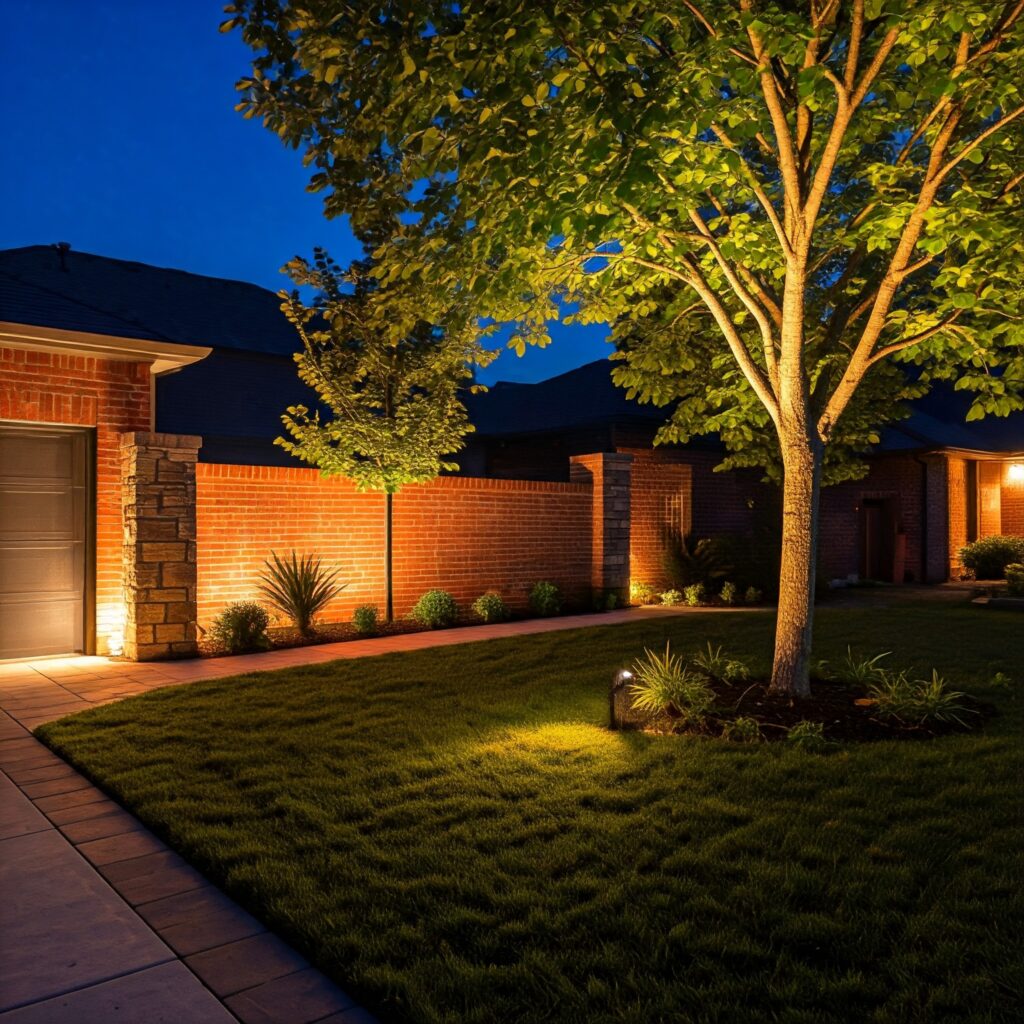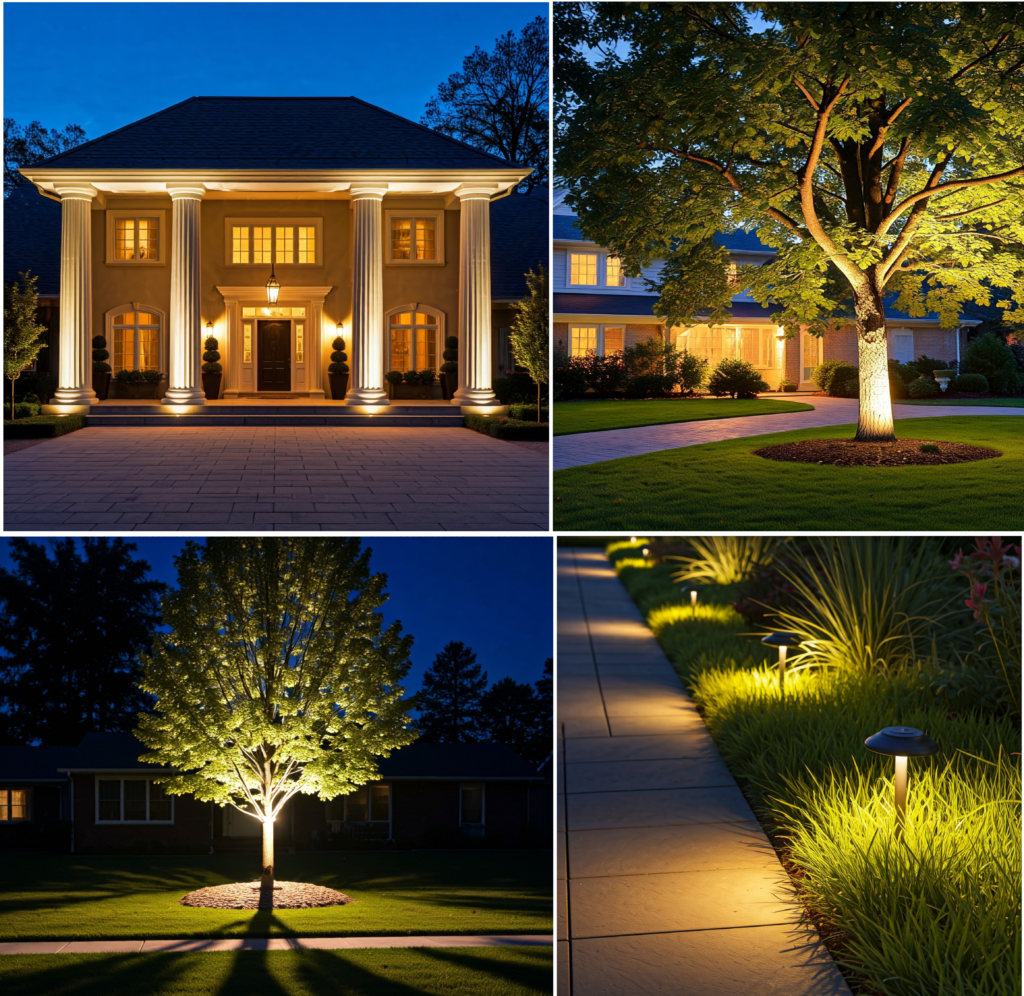Enhancing your home’s curb appeal with landscape lighting is often overlooked. It not only improves safety after dark but also showcases your architectural features. Imagine your home’s elegant lines illuminated in the evening glow, creating a stunning visual impact that draws the eye. In this article, we’ll explore effective ways to use outdoor lighting to highlight your home’s architecture. You’ll learn to choose the right low voltage fixtures and master various lighting techniques. Get ready to transform your outdoor space into a nighttime masterpiece that reflects your style!
Understanding the Basics of Landscape Lighting
Before highlighting your home’s architecture, it’s essential to understand the fundamentals of landscape lighting. This knowledge will help you choose the right fixtures and placements to showcase your property’s unique features.

Common Types of Landscape Lighting:
- Uplighting: Placing lights at ground level and directing them upward creates dramatic effects that accentuate vertical elements like trees or building features.
- Downlighting: Elevated fixtures cast a soft glow downward, simulating natural moonlight and enhancing patios or pathways with subtle illumination.
- Wall-Wash: Illuminating flat surfaces, such as walls or fences creates a soft glow that enhances textures and colors, making architectural elements stand out.
- Pathway Lights: Low-level fixtures line walkways, ensuring safety while guiding guests to your home.
When planning your lighting design, the approach you take to illumination can significantly enhance your landscape’s nighttime aesthetic. Thoughtful lighting choices can transform ordinary features into captivating focal points. Ultimately, the right illumination will create a welcoming and visually stunning outdoor environment after dark.
Identifying Key Architectural Features to Highlight
To make the most of your landscape lighting, it’s important to know which architectural features to spotlight. By focusing on specific elements of your home, you can create a stunning visual impact that draws the eye and enhances your property’s overall charm. Here are some key features to consider:

- Facades: The face of your home is often its most prominent feature. Using uplighting or wall wash lights to create a dramatic effect will enhance the unique textures, colors, and architectural details of your home, making your facade truly shine at night.
- Columns and Pillars: If your home has columns or pillars, these are perfect candidates for uplighting. Highlighting these structures not only showcases their design but also adds a sense of grandeur and sophistication to your entrance.
- Trees: Illuminating trees in your landscape adds depth and beauty to your outdoor space. Uplighting can highlight the graceful silhouettes of their natural forms, while downlighting creates a captivating moonlit effect in the surrounding areas.
- Pathways: Illuminating pathways not only enhances safety and security as you approach your home, but it also adds charm to your entryway and beautifully showcases the surrounding landscape.
By identifying and highlighting these key features, you can create a stunningly illuminated exterior that showcases the beauty of your home’s architecture and landscape, significantly enhancing its overall appeal.
Techniques for Effective Outdoor Lighting
Once you’ve identified the key features to highlight, it’s time to explore the techniques that will bring your landscape lighting to life. The right lighting methods can enhance your home’s beauty while creating a warm and inviting atmosphere.

- Uplighting: Positioning uplight fixtures on the ground and directing light upward to accentuate vertical elements like trees, columns, statues, or fountains creates dramatic shadows and highlights textures, making your home truly stand out against the night sky..
- Downlighting: Also known as moonlighting, downlighting involves installing fixtures high above the ground to cast a soft glow downward. This technique simulates natural moonlight, creating a tranquil ambiance for patios, walkways, and gardens.
- Wall Washing: Wall washing is used to evenly illuminate flat surfaces, such as walls or fences, with soft, diffused light. This technique helps to enhance the textures and colors of the surfaces while creating a gentle glow that adds depth to your outdoor space. It’s particularly effective for highlighting the architecture of your home.
- Shadowing: This technique involves placing lights in a way that casts shadows on the surfaces that will create depth and interest. By adjusting the angle and space between the light and object, you can create shadows that highlight your garden’s features, resulting in a dynamic and visually engaging space.
- Path Lighting: These low-level lights should be evenly spaced along walkways and driveways, casting a warm glow that creates an inviting atmosphere while softly illuminating nearby shrubs and flowers.
Using an effective strategy of illumination to key features of your home with landscape lighting will create a captivating environment around your home at night. Each method contributes to the overall design, ensuring that your space is both functional and aesthetically pleasing.
Choosing the Right Color Temperature
Choosing the right color temperature for your landscape lighting is essential for achieving the desired ambiance. It also enhances the overall aesthetic of your outdoor space. Color temperature, measured in Kelvin (K), influences how warm or cool the light appears and can significantly affect the mood of your environment.

- Warm White (2700K – 3000K): This warm white color temperature mimics the soft glow of traditional incandescent bulbs, accentuating the warmth of brick, wood, and earth tones. It fosters a cozy and inviting atmosphere, making it ideal for pathways, patios, and entryways.
- Neutral White (3000K – 4000K): Neutral white light offers a balanced and natural ambiance that complements gardens and landscapes, enhancing the true colors of plants and flowers without overwhelming them. This color temperature is also effective for highlighting architectural features while preserving a gentle, inviting glow.
- Cool White (4000K – 5000K): Cool white light offers a brighter and more vibrant illumination, making it suitable for areas that require higher visibility, such as driveways and security lighting. This temperature can create a modern look, but it’s essential to use it thoughtfully to avoid a harsh or clinical feel in more intimate settings.
When designing your lighting scheme, strive for a cohesive look by balancing color temperatures. Use warm white lights for pathways and entryways, and neutral white for accentuating trees and architectural features. The right light not only highlights architectural and landscape features but also sets the mood for relaxation and enjoyment in your outdoor oasis.
Designing a Cohesive Landscape Lighting Plan
Creating a cohesive lighting plan is essential for enhancing your home’s architecture and landscape while ensuring a harmonious overall look. A well-thought-out design not only improves aesthetics but also enhances safety and functionality.

- Assess Your Space: Evaluate your property to identify the features you want to highlight and the areas that require illumination. Take note of architectural elements, landscaping feature points, pathways, and potential security concerns. This assessment will help guide your lighting choices and placement.
- Create a Lighting Layout: Sketch a layout of your outdoor space and mark where you plan to place fixtures. Consider using a mix of lighting techniques, such as the ones discussed in this article to create layers and depth.
- Balance Light Levels: Aim for a balance of light levels across your space. Avoid overly bright or dark areas by ensuring that light is evenly distributed. This will create a seamless transition between illuminated and shadowed spaces, enhancing the overall ambiance while providing safety.
- Consider Fixture Styles: Select fixtures that complement your home’s architectural style and landscape design. Whether you prefer modern, traditional, or rustic designs, ensure that your lighting choices harmonize with the overall aesthetic. Consistent styles will contribute to a unified look.
- Test and Adjust: After installing your lighting, take time to test the effects at night. Walk through your space to see how the lighting highlights features and creates ambiance. Be prepared to adjust the angles, brightness, or even the types of fixtures to achieve your desired effect.
A carefully considered approach to designing a cohesive lighting plan not only highlights your home’s beauty at night but also enhances the functionality and security of your outdoor spaces. This thoughtful design ensures that every corner of your yard is both aesthetically pleasing and safe, allowing you to enjoy your outdoor areas with peace of mind, whether you’re entertaining guests or simply relaxing in the evening glow.
Conclusion
In conclusion, low voltage landscape lighting is an essential but often overlooked element of enhancing your home’s curb appeal. Thoughtfully integrating lighting improves safety and creates a captivating ambiance that showcases your home’s beauty. Techniques like uplighting, downlighting, and wall washing, along with careful color temperature choices, bring out the best in your property.
As you prepare to add lighting, assess your space and develop a balanced layout. Choose fixtures that complement your home’s style. Test and adjust placements at night to achieve the perfect ambiance. With these strategies, you’ll elevate your home’s charm and create a warm, inviting atmosphere for family and friends.
Embrace landscape lighting to enhance your outdoor living experience. Your thoughtfully designed plan will ensure your home shines beautifully, creating lasting memories in an illuminated setting.

Additional Reading:
Looking for additional tips: Check out this page from Kichler Lighting
Considering hiring a pro? Check this post out and then get in touch with us for a free consultation if you’re local.

Pingback: Spring Landscaping Magic: Create a Yard That Inspires - Perfection Landscape Mgt.
Pingback: Front yard Landscape Design Secrets